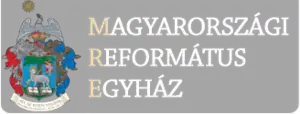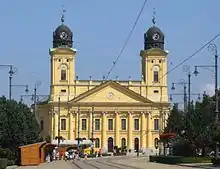Reformed Church in Hungary
The Reformed Church in Hungary (Hungarian: Magyarországi Református Egyház, MRE) is the largest Protestant church in Hungary, with parishes among the Hungarian diaspora abroad. Today, it is made up of 1,249 congregations in 27 Presbyteries and four Church districts and has a membership of over 1.6 million, making it second only to the Roman Catholic Church in terms of size. As a Continental Reformed church, its doctrines and practices reflect a Calvinist theology, for which the Hungarian term is református (pronounced [ˈrɛformaːtuʃ]).
| Reformed Church in Hungary | |
|---|---|
 Logo of the Reformed Church in Hungary. | |
| Classification | Protestant |
| Orientation | Calvinist |
| Theology | Reformed |
| Polity | Mostly Episcopal |
| Associations | Hungarian Reformed Church, World Council of Churches, World Communion of Reformed Churches, Conference of European Churches, Community of Protestant Churches in Europe, Ecumenical Council of Churches in Hungary |
| Region | Hungary, Hungarian diaspora |
| Origin | 1567 |
| Separations | Reformed Presbyterian Church of Central and Eastern Europe (1998) |
| Congregations | 1,249[1] |
| Members | 2,500,000 |
| Ministers | 1,550 |
| Official website | http://www.reformatus.hu/english/ |
History
The Reformation spread to Hungary during the 16th century from Geneva, Switzerland. John Calvin encouraged and trained thousands of men to distribute the gospel across the continent, which included the mass printing of the Bible and Christian works in the local languages.
As a result of the Ottoman invasion of Hungary, Hungary was divided into three parts in the 16th century. The northwest came under Habsburg rule, the Eastern part of the kingdom and Transylvania (vassal state) under the Ottoman Empire. The Ottoman Turks did not urge Muslim conversion among the conquered. The Reformation thus spread through the Turkish occupied territories. Only in the Habsburg-ruled Western Hungary was this process halted by the strong counter-Reformation policy of the Empire.
A Reformed Constitutional Synod was held in 1567 in Debrecen, the main hub of Hungarian Calvinism, where the Second Helvetic Confession was adopted as the official confession of Hungarian Calvinists.
In the late 17th century, all of Hungary was gradually liberated from the Turks by a pan-European alliance led by the Habsburgs. After this, the Habsburg Emperors started to exercise their very aggressive counter-Reformation policy on the liberated territories. Consequently, in the third part of the 17th century and in most of the 18th century, Hungarian Protestants were viewed as second-class citizens in Hungary. Imperial edicts such as the Resolutio Carolina of 1731, settled the status of Protestant churches.
Only the end of the 18th century brought some relief to the Hungarian Reformed Church. Finally, the 1867 establishment of the Austro-Hungarian Monarchy, gave free way for the emancipation of Hungarian Protestants. In 1881, for the first time in an almost 400-year-long history, the four Hungarian Reformed Church Districts together with the Transylvanian Reformed Church held a united Synod meeting in the city of Debrecen. The modern Hungarian Reformed Church was born there at the Debrecen Synod of 1881. The inner hierarchy and the synodal-presbyterian system of the Reformed Church remains nearly unchanged from that time.
After World War I, the Peace Treaty of Trianon in 1920 greatly altered the shape of the Hungarian Reformed Church. It cut off two-thirds of Hungary's territories, and consequently a large number of Hungarian Reformed people now live in the surrounding countries. Proportion of Protestants within Hungary has been stable over the last century (1938-2010), oscillating between 10% and 20% of the population.
Another trial came to the Church with the Communist dictatorship following World War II. After the confiscation of church estates, schools and institutions, the Communist government forced the Reformed Church to sign an agreement with the state on 7 October 1948 that brought all work and personnel of the Church under the control of the state and the Communist Party. The forty years of Communist rule brought a great setback for the Hungarian churches, and only the political changes of the 1990s brought about relief. Thereafter, a "free church in free state" model was adopted.[2]
Theology
The Reformed Church in Hungary accepts the Bible as the word of God. Beyond the early creeds Athanasian Creed, Apostles Creed, Nicene Creed, it accepts the Heidelberg Catechism, and the Second Helvetic Confession.[3][4]
Organization
In order to organize church life on regional and national levels, the RCH has established higher structural bodies for church legislation and operation: 27 presbyteries, four districts and the General Synod. Presbyteries usually contain approximately 30-40 congregations and have mainly administrative roles; each Presbytery belongs in one of the four church districts: Cistibiscan, Transtibiscan, Danubian or Transdanubian. The ultimate source of church legislation and administration of the Reformed Church in Hungary is the General Synod.
The RCH (as a member of the worldwide Reformed Church family) is constructed in a representative way from below, from the congregational level. Members of governing bodies on all levels of the church are elected by a group of church members, and in all levels above the congregational pastors and lay people are represented equally.
The church levels function independently providing various kinds of service and using their own budget. A common church constitution, together with a set of specific rules and regulations, makes it possible for different units of the church to create their own operational design. However, for certain transactions they depend on higher church bodies. These general rules allow for freedom and flexibility in the congregations' operation, but they also protect the integrity of the church.[5]
Hungarian Reformed Church
The Hungarian Reformed Church (HRC) was established by the Constituting Synod on 22 May 2009 in Debrecen. It is a community of Reformed churches in the Carpathian Basin that incorporates Hungarian Reformed congregations both within and outside the borders of Hungary because of their separation from each other as a consequence of World War I. The constitution of the church declares that the HRC is a community of joined churches with a common synod known as the General Convent, which can pass legislation and make formal statements concerning issues decided upon by the participating churches. However, the joined churches are autonomous and independently form their own organizational systems.
The constitution of the Hungarian Reformed Church was ratified by the following churches:
International ecumenical relations
The RCH is a member of several ecumenical organisations and partner organisations, including:
- World Communion of Reformed Churches
- Community of Protestant Churches in Europe
- Conference of European Churches
- Church and Society Commission of CEC
- Eurodiaconia
- Churches' Commission for Migrant in Europe
- World Council of Churches
- Partnerhilfe
- Gustav Adolf Werk
- HEKS (aid organization of the Protestant churches in Switzerland)[7]
References
- "World Council of Churches - Reformed Church in Hungary". Archived from the original on 2011-05-21. Retrieved 2009-12-18.
- "Reformatus.hu - History of the RCH".
- "Reformatus.hu - Our Call".
- Fasse, Christoph. "Address data base of Reformed churches and institutions".
- "Reformatus.hu - Facts and Statistics".
- "Reformatus.hu - Hungarian Reformed Community".
- "Reformatus.hu - Partnership and Co-operation".
External links
- http://www.reformatus.hu/ Official site (in Hungarian)
- http://www.reformatus.hu/our-church/ Official site (in English)
- http://www.calvinsynod.org Calvin Synod of the UCC
- http://www.reformatus.us Reformatus.us Hungarian Reformed Church news
- Calvin & Missions - Dr. Michael Haykin Lecture, Reformation to Hungary

